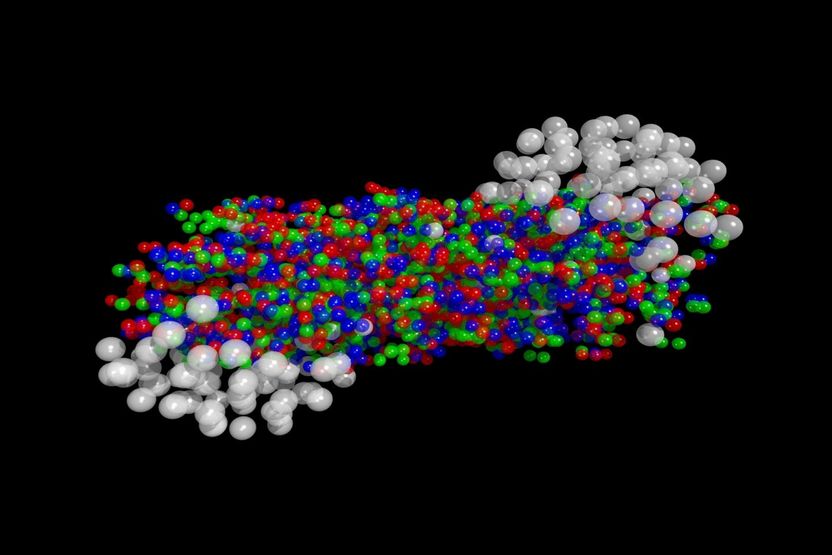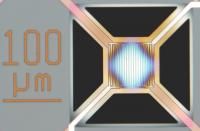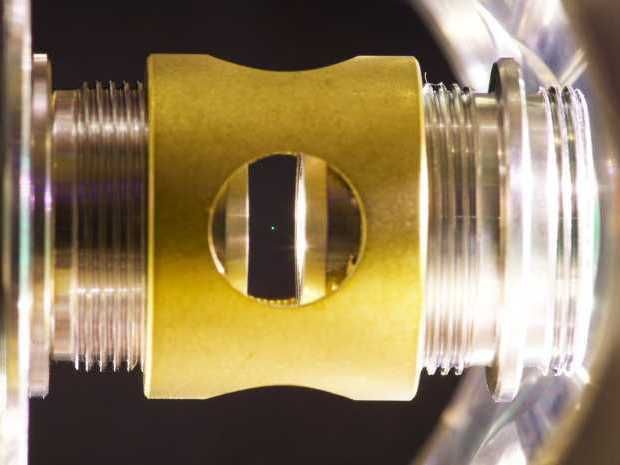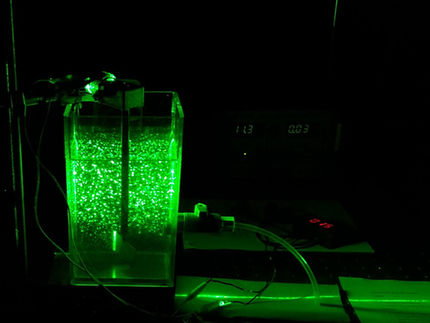Chemists synthesise the smallest nano-sized particles to detect heavy metal ions in water
Scientists at St Petersburg University, Sirius University of Science and Technology, and St Petersburg Academic University have synthesised the smallest nano-sized metal-organic frameworks to detect heavy metal ions in water. The results and outcomes of the experiments and description of the properties of the crystals are published in Nanomaterials.

The presence of metal ions can quench the luminescence of the Eu-based metal-organic frameworks
SPbU
Metal-organic polymers, or metal-organic frameworks (MOFs), are crystals composed of metal ions interconnected by organic molecules, i.e. organic linkers. Various concentrations of the metal ions and organic linkers can be used to synthesise materials with different structures and properties. MOFs are widely used to design electro-chemical sensors as reaction catalysts in chemical industry or propellant additives.
Some of the MOFs are luminescent MOFs. They emit light caused by UV rays, electromagnetic field, or other disturbances. Luminescent MOFs are actively used as LED components and luminescent thermometers. Additionally, they are used in diagnosis of cancer. Luminescent MOFs are also used as luminescent sensors for pollutants.
St Petersburg University chemists synthesised the smallest nano-sized crystals by the ultrasound-assisted wet-chemical method. They were synthesised by a slow mixing of sodium terephthalate and europium chloride aqueous solutions by using the ultrasound-assisted wet-chemical method, precipitated in the form of a polycrystalline solid. Ultrasonication ensured a better mixing of solution, slowed growth of particles, prevented the aggregation of the microparticles, and resulted in the formation of individual microparticles.
The scientists synthesised particles of various sizes. The average particle size can be equal 8 nm up to hundreds micrometres. Today, the reported europium(III) terephthalate tetrahydrate (Eu2bdc3·4H2O) metal-organic frameworks nanoparticles are the smallest nano-sized rare-earth-based MOF crystals.
‘We did not expect that a twofold decrease in the concentration of reagents could lead to size reduction for several orders. Presumably, this effect may be due to europium-terephthalate 1:1 complex. This can accelerate the growth process of the particles. Earlier, scientists could synthesise nano-sized particles of terephthalate that were equal to 40 nm or even more. We managed to synthesise particles with the fivefold smaller size,’ said the head of the research, Associate Professor in the Department of Laser Chemistry at St Petersburg University and Doctor of Chemistry Andrey Mereshchenko.
The developed method to synthesise nanoparticles can make a positive contribution to nanotechnology and coordination chemistry. By using this method, we can synthesise nanoparticles from other MOFs. The experiments also reported the selective luminescence quenching by heavy metal ions. As a result, the synthesised nanoparticles can be used as sensors to detect heavy metal ions in water.
‘This discovery has a potential to develop efficient sensors to monitor heavy metal ions in drinking water. Our luminescent MOFs demonstrate significantly lower limits of detection on heavy metal ions. This will ensure more accurate measurements of pollutants in water, even in small concentrations’, said Viktor Nosov, a co-author of the article and a student in Chemistry at St Petersburg University.
The reported nanoparticles can also be used as luminescent sensors to detect Cu2+, Cr3+, and Fe3+ ions in water. The presence of these metals in water poses a threat to human beings and animals. Heavy metal accumulation in the body can effect human metabolism and lead to nervous system diseases, vascular diseases, and digestive disorders. The chemists are planning to continue the research and develop an express test to detect heavy metal ions in drinking water and waste.
Original publication
Other news from the department science
These products might interest you

NANOPHOX CS by Sympatec
Particle size analysis in the nano range: Analyzing high concentrations with ease
Reliable results without time-consuming sample preparation

Eclipse by Wyatt Technology
FFF-MALS system for separation and characterization of macromolecules and nanoparticles
The latest and most innovative FFF system designed for highest usability, robustness and data quality

DynaPro Plate Reader III by Wyatt Technology
Screening of biopharmaceuticals and proteins with high-throughput dynamic light scattering (DLS)
Efficiently characterize your sample quality and stability from lead discovery to quality control

Get the chemical industry in your inbox
By submitting this form you agree that LUMITOS AG will send you the newsletter(s) selected above by email. Your data will not be passed on to third parties. Your data will be stored and processed in accordance with our data protection regulations. LUMITOS may contact you by email for the purpose of advertising or market and opinion surveys. You can revoke your consent at any time without giving reasons to LUMITOS AG, Ernst-Augustin-Str. 2, 12489 Berlin, Germany or by e-mail at revoke@lumitos.com with effect for the future. In addition, each email contains a link to unsubscribe from the corresponding newsletter.
Most read news
More news from our other portals
See the theme worlds for related content
Topic world Synthesis
Chemical synthesis is at the heart of modern chemistry and enables the targeted production of molecules with specific properties. By combining starting materials in defined reaction conditions, chemists can create a wide range of compounds, from simple molecules to complex active ingredients.

Topic world Synthesis
Chemical synthesis is at the heart of modern chemistry and enables the targeted production of molecules with specific properties. By combining starting materials in defined reaction conditions, chemists can create a wide range of compounds, from simple molecules to complex active ingredients.
Topic world Sensor technology
Sensor technology has revolutionized the chemical industry by providing accurate, timely and reliable data across a wide range of processes. From monitoring critical parameters in production lines to early detection of potential malfunctions or hazards, sensors are the silent sentinels that ensure quality, efficiency and safety.

Topic world Sensor technology
Sensor technology has revolutionized the chemical industry by providing accurate, timely and reliable data across a wide range of processes. From monitoring critical parameters in production lines to early detection of potential malfunctions or hazards, sensors are the silent sentinels that ensure quality, efficiency and safety.
Last viewed contents
I._M._Dharmadasa

Soluble Elements from a New Corner of the Periodic Table
Table_of_nuclides,_25-48
Steam_drum
Møller-Plesset_perturbation_theory
Twisting graphene into spirals - Researchers synthesize helical nanographene

The most exotic fluid has an unexpectedly low viscosity
Gramicidin

Sniffing out a better chemical sensor - Researchers at the NIST have created a new approach for “electronic noses”
Analytik Jena Delivers Instruments for Environmental Analysis to Poland
Corpuscularianism





























































